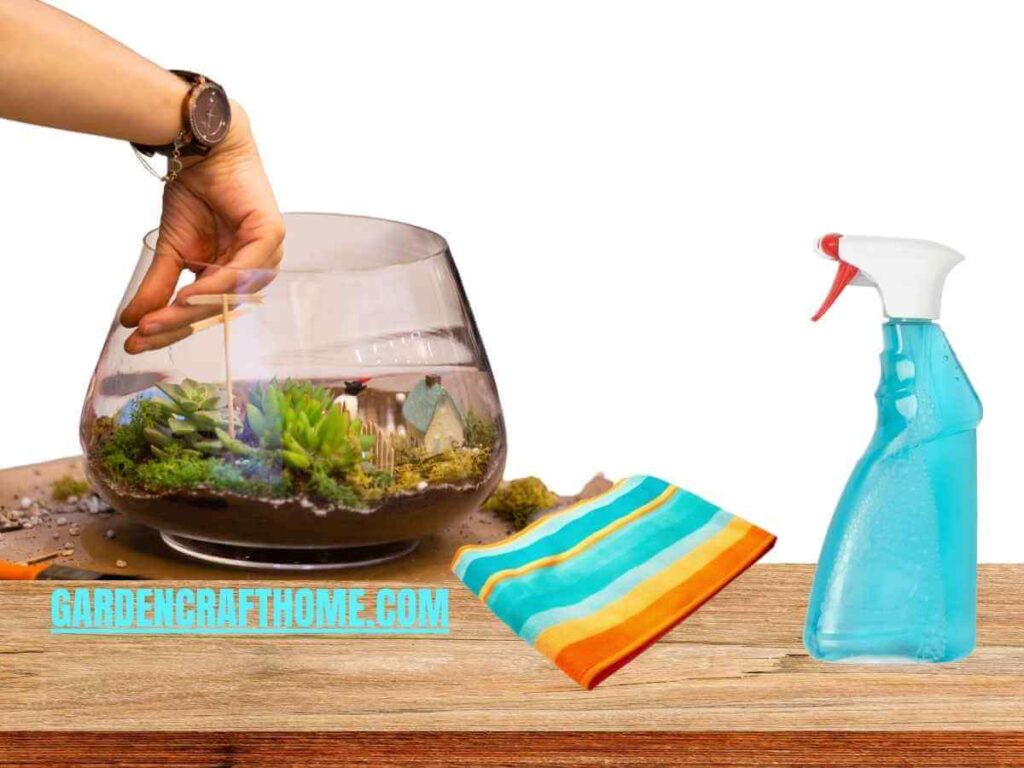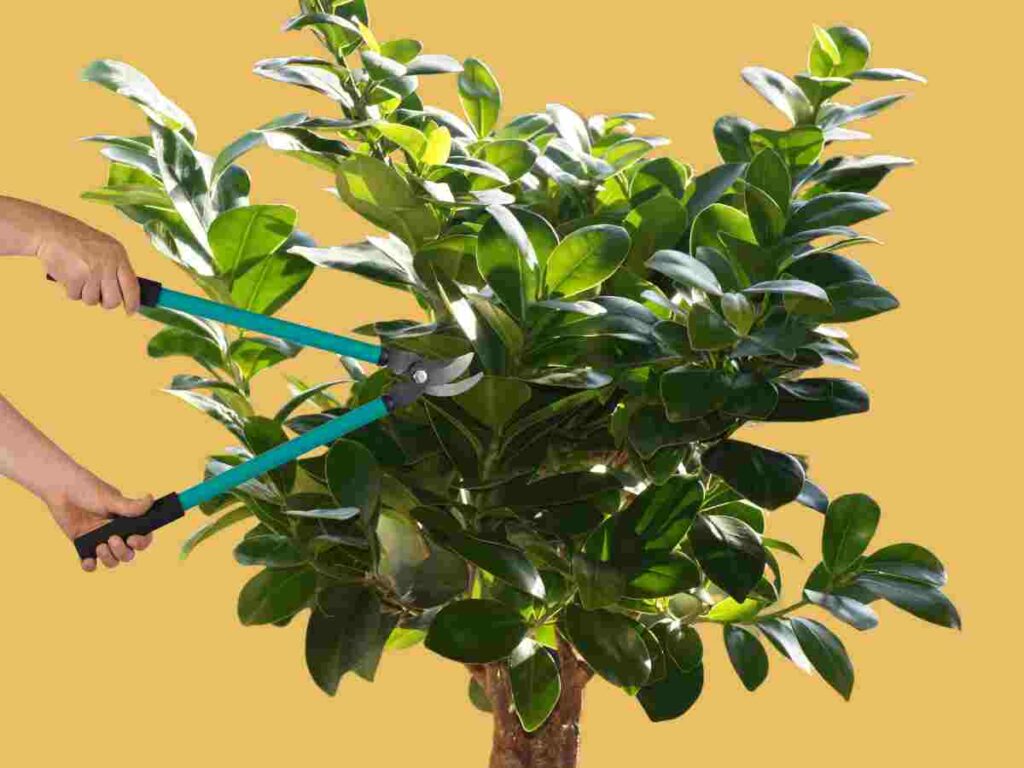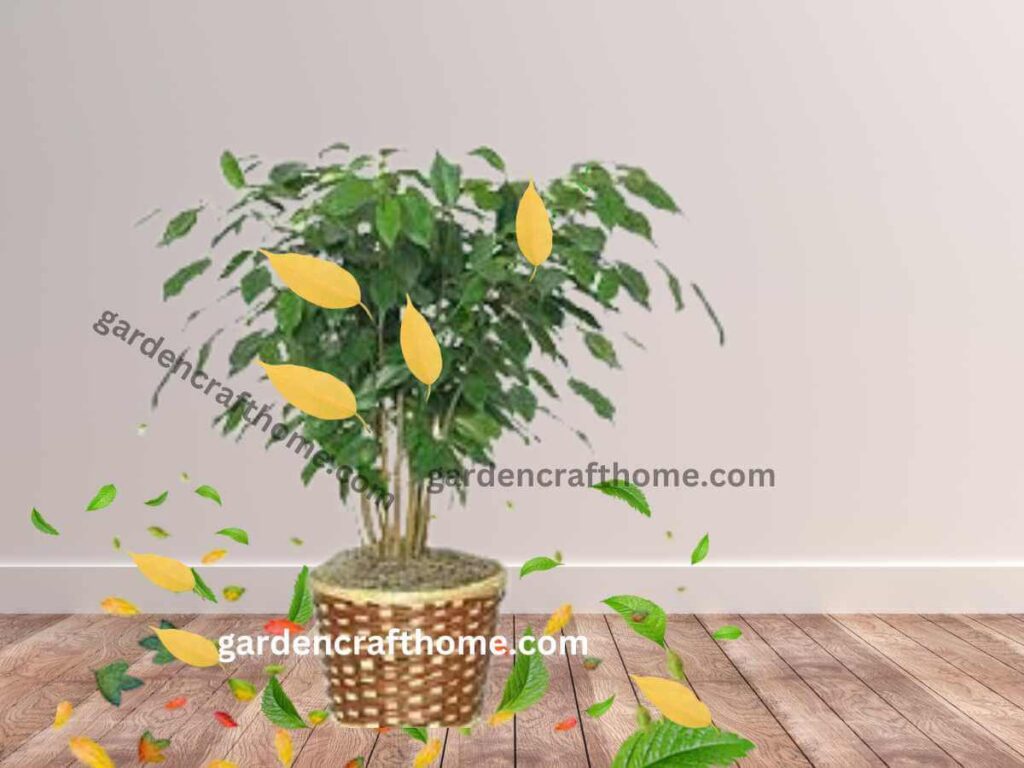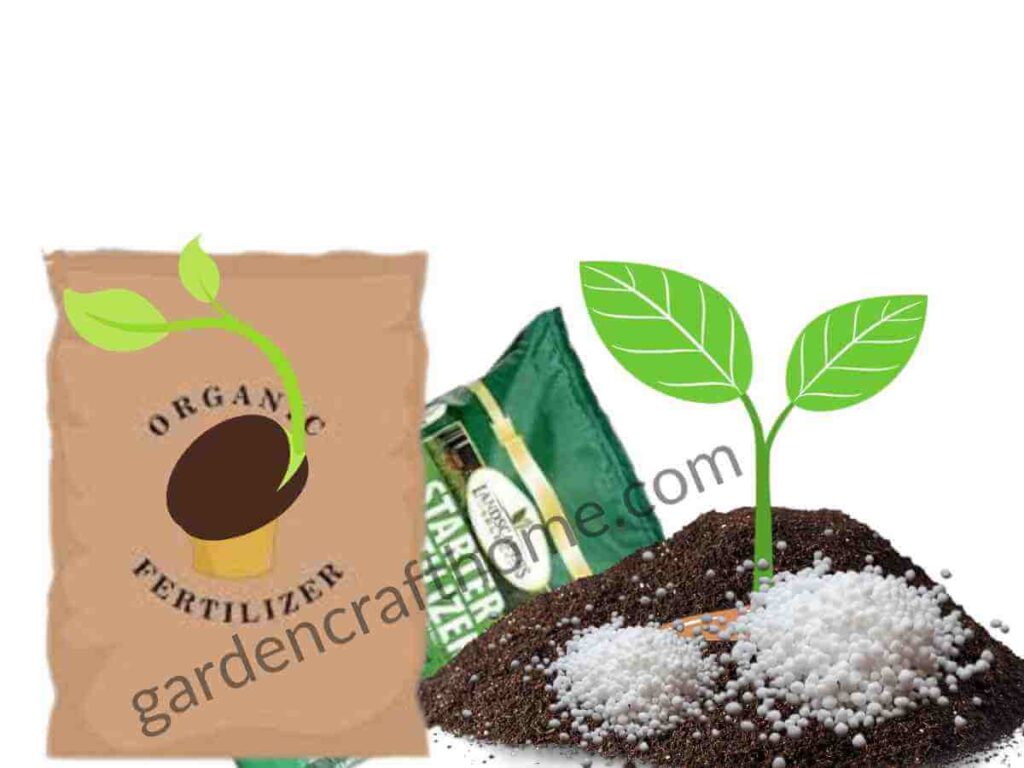In this post, we quickly see how to clean terrarium glass so that it looks fantastic and the plants inside receive more light.
Before starting, we need to understand what makes the glass of the terrarium dirty; very often, these are marks due to limescale residues, but they can also be dust or fingerprints that we left while handling it.
In any case, the process is straightforward, and no special products are needed.
What Is Needed To Clean The Glass Of The Terrarium
Here’s what you need:
· 1 clean microfiber cloth (for a large terrarium)
· 1-2 cotton pads (for a small terrarium)
· Lukewarm demineralised water
This should be enough to remove fingerprints and dust without leaving streaks.
If there are limescale residues, I recommend diluting a little white wine vinegar in the water to make it more acidic and effective.
How To Clean Terrarium Glass
To clean the internal glass of a terrarium, you need to soak the microfiber cloth in warm, demineralized water.
Once the clothes get wet, wring them out well, then gently rub the walls until the job is completed.
Limescale build-up is slightly more difficult to remove and requires an acidic solution.
In this case, add about 1/5 cup of white wine vinegar to the water before starting.
Suppose the mouth of the terrarium is very small. In that case, it does not allow us to enter with our hands, and we must, therefore, equip ourselves with the following.
We are going to use more or less long, curved tweezers to rub a wet cotton pad along the walls.
The external glass of the terrarium can be cleaned with any glass cleaner, being careful not to spray it inside.
As a precaution, I prefer to apply the product to the cloth and pass it on the outside of the terrarium once it is damp.
How Often Should The Terrarium Be Cleaned?
As far as cleaning the windows is concerned, there is no set timing; the outside tends to get dusty more quickly and can be polished whenever desired.
The inside gets dirty more slowly, especially if we water the terrarium with filtered water, which leaves very few (or no) limescale marks.
If you’re interested in a reading How To Make A Vertical Succulent Garden With Frame click here
Specific Products For Cleaning The Terrarium
Although cleaning the glass of the terrarium is often simple, there are cases in which the dirt does not come off so easily.
In these cases, specific products can be used, such as the Glass Cleaner by Exoterra, a leading company in the production of terrariums for amphibians, reptiles, and plants.
Should I Clean Both The Outside And The Inside Glass?
To maintain its clarity and aesthetics, it’s a good practice to clean both the inside and the outside.
The outside of your terrarium glass may get dirty as well due to dust and fingerprints by adults or children.
If you clean the inside of your terrarium glass and it looks clean, but you can view it from the outside, then what is it like?
So proper maintenance or cleaning is required both inside and outside. To learn more about maintaining and caring for a terrarium, click here to read. [link
Can I Use Regular Glass Cleaners?
Ordinary glass cleaners aren’t the best solution for your terrarium, even if they can seem like the standard.
These cleaners usually include chemicals that might harm your plants or upset the delicate ecological balance in your terrarium.
Sticking to natural solutions like vinegar and water is safer and preferable.
In this manner, you secure a clean glass without any hazards to your plants.
Click here read about Monstera Adansonii Care.
Can I Used Vinegar To Clean Terrarium Glass?
Because vinegar is natural and less damaging to plants than synthetic cleaning chemicals, using it to wipe the glass in your terrarium is harmless.
You may mix vinegar with water and spray it on the damaged region of the glass because it is safe for our terrarium glass.
Allow the vinegar to neutralize the stain, and after some time, clean off the dirt with soft clothes that won’t scratch the glass.
Once you are done, you will observe that your glass is sparkling again without chemical reactions or harming your plant.
Click this link to read How to Prepare the Substrate of a Glass Plant Terrarium if this interests you. [Link]
Can Paper Towels Be Used Instead Of Microfiber Cloths?
Paper towels may include fibers or lint that might get into your plants or adhere to the glass, so you might want to avoid using them.
A soft microfiber cloth works best since it is gentle, absorbent, and residue-free.
Additionally, because microfiber clothes are machine-washable and reusable, they are less expensive. Just wash them as required.
What Should I Do If There Are Mineral Deposits On The Glass?
Although mineral deposits may be troublesome, a vinegar solution is much more effective than them.
After combining vinegar and water, mist the impacted regions and let it do its job for a few minutes.
Next, remove the debris with a gentle scrape or soft cloth.
After rinsing with water, pat dry. Your plants will appreciate that those bothersome minerals are no longer in your glass.
Do I Need To Remove My Plants And Decorations Every Time I Clean The Glass?
It’s not always necessary to remove your plants and decorations every time you clean the glass.
Unless you have a smaller terrarium or intricate decorations, it might be easier to take them out temporarily.
Provide that your terrarium glass is large enough to contain your hand, meaning there is no need to remove your plants and decorations.
If you remove it, maybe because of limited space, make sure to put everything back in place once you’re done cleaning.
Can I Clean The Glass While The Plants Are Still Inside?
With your plants inside, you can definitely clean the glass. But there are safety precautions to consider.
If you are spraying your water and vinegar with spray, try to avoid directly spraying your plants.
It is better to stop using a spray can because a spray can split the solution over the plant.
It will be best if you spray the solution onto soft clothes or a sponge, then scrub the glass gently to remove the dirt. This will be the best option.
As I said earlier, if you would like to remove your plant and decorations, then do it gently.
However, if you have enough space for your hands to enter, there is no need to remove those plants.
Also read How To Propagate Spider Plant Read now
What Stains May A Closed Terrarium Acquire?
Which sorts of dirt are common in enclosed terrariums? They can come in more colors than you may expect. But what are they?

The Green Spots, Or Algae Growth
If the walls of your container appear green, you most likely have some algae.
Your closed terrarium is an excellent home for algae because it is much more humid inside, and water pours down the walls on a regular basis.
They are a regular component of your closed terrarium’s ecosystem and do not pose a threat. Simply put, they lack beauty.
Fungal Growth:
Fungal growth on the glass surfaces of closed terrariums may also occur because of the existence of fungi, such as yeast or mold.
Proper cleaning is needed because fungi can develop in damp conditions, particularly in areas where organic matter is decomposing.
Brown Or Black
Small brown or black dots may form over time. These might be soil brought there by growing plants or dung from insects.
They are also not harmful to the environment, although they are not very appealing to the eye.
Water Stains:
These stains appear on glass surfaces because water droplets evaporate, leaving behind mineral deposits or residue.
These stains may become more noticeable with time and lessen the glass’s clarity.
White Or Gray?
Some areas of your glass may have white and gray streaks. Limestones, or mineral deposits, are examples.
They either originate from the regular water cycle or from creatures that crawl along the walls, such as worms, snails, and insects.
In a confined terrarium, lime is not uncommon. Lime is present in both our tap water and the calcite sand used in terrarium construction.
Carnivorous plants in confined terrariums actually cannot tolerate any lime, so you will need to use caution when adding lime.
It might also be mold, which you should remove as soon as possible to prevent it from depleting your plants of all their nutrients.
How Can I Prevent Water Stains On The Glass?
To prevent water stains on the glass, you should follow the following steps:
1. When you water your plants, try not to spray water straight onto the glass. Instead, use a watering can or a gentle sprayer to target the soil.
2. Provide your terrarium with proper ventilation to reduce condensation buildup.
3. Use a vinegar solution to clean often to help stop water stains from developing.
Are There Any Special Considerations For Different Types Of Terrariums (Closed Vs. Open)?
Yes, indeed! Closed and open terrariums have slightly different maintenance needs.
We observe that more moisture is often trapped in closed terrariums than in open terrariums.
The moisture then hastens the development of algae and causes condensation on the glass.
It is always important to keep an eye on your plant’s humidity level and ensure that it is getting enough air in order to prevent mold and mildew from developing.
To prevent soil from drying out and plants from withering, open terrariums may require more regular watering and ventilation.
Also, read How to Care for Asparagine at Home. Read now. [link]
How Do I Remove Hard Water Stains And White Calcium From A Glass Terrarium?
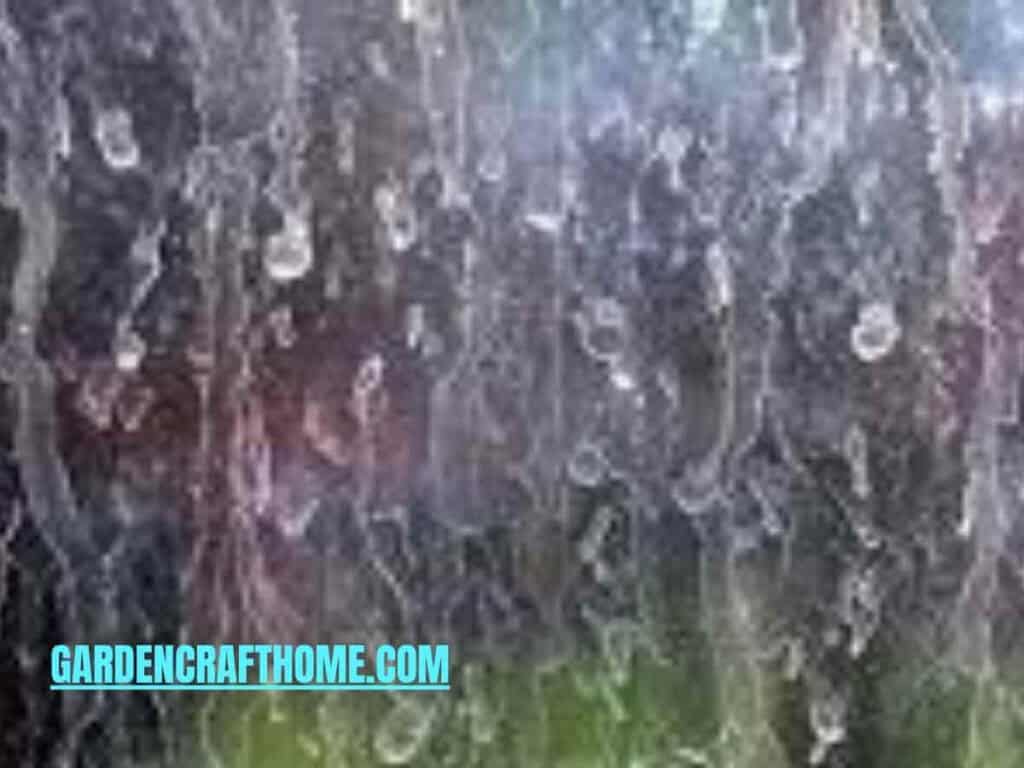
In a spray bottle, combine vinegar and water to create the cleaning solution.
Calcium deposits are effectively dissolvable and removed by vinegar because of its acidic qualities.
Apply the solution: spray the solution to the affected or white calcium deposit areas. Make sure it reaches them, but avoid spraying it directly on the plant.
Wait for a while. Allow the vinegar to work. The vinegar will help soften the dry, white calcium deposits on the glass.
Start Scrubbing Gently: scrub the affected area with soft clothes; avoid using rough clothes as it might damage the face.
Rinse with Water: music clean water to rain, wash out, and inspect if there is a reminisce of being dirty.
Repeat if necessary: if in any way you discover that the glass isn’t clean, then repeat the washing process.
Dry the Glass: Wait for the glass to dry, and then it will be ready for use.
Prevent Future Buildup: It is necessary To prevent white calcium deposits from happening again.
The only thing you will do regularly is clean and maintain your terrarium to minimize the accumulation of minerals and debris.
In addition, it is better to consider using distilled water to water your terrarium plants.
Read the following if you are interested:
How Often Do You Water Bonsai Trees?
Introduction to Bonsai for Beginners
The Best Type of Bonsai Tree for Beginners
How to Take Care of a Bonsai Tree
How to Make a Small Wooden Planter Box
How to Install a Vertical Garden Wall
How to Build a Planter Outdoor with Bricks
How to Make a Homemade Planter
How to Make a Planter With Sleepers Wood
Summary
Now you have seen that cleaning a terrarium glass both inside and outside is the same as cleaning a regular glass.
One thing I should remind you of is always to avoid spraying those chemicals on your plants, but I will advise you to use vinegar and water instead.
Keep proper maintenance your number one priority. To read more about the appropriate maintenance of this plant, click here. [link]
To have a better collection at home, you can also read 21 Plants Suitable for a Closed Terrarium. Read now. [link]

